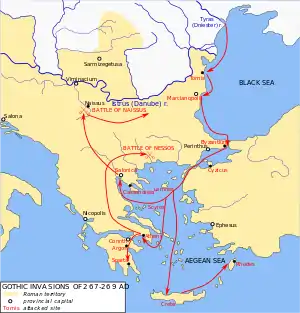267
Year 267 (CCLXVII) was a common year starting on Tuesday (link will display the full calendar) of the Julian calendar. At the time, it was known as the Year of the Consulship of Paternus and Arcesilaus (or, less frequently, year 1020 Ab urbe condita). The denomination 267 for this year has been used since the early medieval period, when the Anno Domini calendar era became the prevalent method in Europe for naming years.
| Millennium: | 1st millennium |
|---|---|
| Centuries: | |
| Decades: | |
| Years: |
| 267 by topic |
|---|
| Leaders |
|
| Categories |
|
| Gregorian calendar | 267 CCLXVII |
| Ab urbe condita | 1020 |
| Assyrian calendar | 5017 |
| Balinese saka calendar | 188–189 |
| Bengali calendar | −326 |
| Berber calendar | 1217 |
| Buddhist calendar | 811 |
| Burmese calendar | −371 |
| Byzantine calendar | 5775–5776 |
| Chinese calendar | 丙戌年 (Fire Dog) 2963 or 2903 — to — 丁亥年 (Fire Pig) 2964 or 2904 |
| Coptic calendar | −17 – −16 |
| Discordian calendar | 1433 |
| Ethiopian calendar | 259–260 |
| Hebrew calendar | 4027–4028 |
| Hindu calendars | |
| - Vikram Samvat | 323–324 |
| - Shaka Samvat | 188–189 |
| - Kali Yuga | 3367–3368 |
| Holocene calendar | 10267 |
| Iranian calendar | 355 BP – 354 BP |
| Islamic calendar | 366 BH – 365 BH |
| Javanese calendar | 146–147 |
| Julian calendar | 267 CCLXVII |
| Korean calendar | 2600 |
| Minguo calendar | 1645 before ROC 民前1645年 |
| Nanakshahi calendar | −1201 |
| Seleucid era | 578/579 AG |
| Thai solar calendar | 809–810 |
| Tibetan calendar | 阳火狗年 (male Fire-Dog) 393 or 12 or −760 — to — 阴火猪年 (female Fire-Pig) 394 or 13 or −759 |

Gothic invasions of 267-269
Events
Roman Empire
- First Gothic invasion: The Goths, originally from Scandinavia, with the Sarmatians (from modern Iran), invade the Balkans and Greece. They ravage Moesia and Thrace.
- The Heruli invade the Black Sea coast; they unsuccessfully attack Byzantium and Cyzicus. The Roman fleet defeats the Herulian fleet (500 ships) but allows them to escape into the Aegean Sea, where they raid the islands of Lemnos and Skyros.
- The Goths sack several cities of southern Greece including Athens, Corinth, Argos and Sparta. After the Sack of Athens, an Athenian militia force (2,000 men), under the historian Dexippus, pushes the invaders to the north where they are intercepted by the Roman army under emperor Gallienus. He wins an important victory near the Nestos River, on the boundary between Macedonia and Thrace.
- Aureolus, charged with defending Italy, defeats Victorinus (co-emperor of Gaul), is proclaimed emperor by his troops, and begins his march on Rome.
Near East
- King Septimius Odaenathus of Palmyra makes plans for a campaign in Cappadocia against the Goths. He is assassinated, along with his eldest son, most probably by his nephew due to a previous altercation between him and Odaenathus.[1] His wife Zenobia succeeds him, and rules Vaballathus (the Palmyrene Empire) with her young son.
Births
- Pei Wei (or Yimin), Chinese philosopher and politician (d. 300)
Deaths
- Septimius Herodianus, co-king of Palmyra (assassinated)
- Septimius Odaenathus, king of Palmyra (assassinated)
References
- Dodgeon & Lieu 2002, p.72
This article is issued from Wikipedia. The text is licensed under Creative Commons - Attribution - Sharealike. Additional terms may apply for the media files.